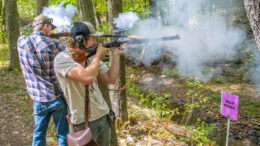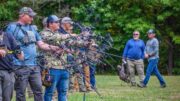There was, surprisingly, no competition on that day, just as there is not so surprisingly little to none on most days in this era.
There’s a New World Order of sorts in the outdoors.
On that afternoon more than three decades ago – my first as a gun-carrying hunter – my grandfather picked me up at my parents’ home and drove us to a neighbor’s farm. A cousin two years older than me accompanied us.
It was mid-October and we were hunting squirrels.
We saw no other hunters in that half day afield. That was unusual, as I came to find out in subsequent years.

Squirrel hunting is not as popular as it once was. But it remains a fun-filled hunt with lots of camaraderie.
As a general rule, lots of hunters – close to half a million across my native Pennsylvania – hunted squirrels then. They were equally popular in many states.
Indeed, small game hunting in general, and squirrel hunting in particular, was the everyman’s game.
Perhaps – and only perhaps — rabbits drew a bigger following than squirrels. Truth be told, most hunters who sought one did the other, often in the same day.
A lot of the men – and they were mostly men — prowling the woods for them were of my grandfather’s generation. They’d grown up hunting for fun, yes, but also for food. A half dozen squirrels was a bounty to be thankful for.
People acknowledged it, too.
My grandfather, who married just as America plunged into the Great Depression, told tales of ending days afield by riding the streetcar home through the Pittsburgh suburb of McKeesport. He’d have a shotgun in one hand, his hunting coat in another.
Neither caused panic or screams. But a bulging game pouch would elicit sometimes envious questions about what he’d bagged.
The pressure to provide was great enough that a friend, often less successful, would stuff his pouch full of leaves if necessary rather than make it obvious he was coming home empty handed.
I never experienced anything like that, but I knew competition in the squirrel woods. To pursue them on public land years ago meant wandering oak ridges, always half expecting to see another orange-clad chaser of bushytails in “your” spot.
No longer.
A number of factors – the surge in archery hunting’s popularity primarily, but also loss of free time, changing family demographics and the kind of sprawl that means fewer close-to-home woodlots open to people carrying firearms – have dramatically thinned small game hunting’s ranks. Participation nationwide has declined by 70 percent or more.
The squirrels, though, are out there. Populations are, in many states, as high as they’ve been in decades, courtesy of a landscape dominated by mature, mast-bearing forest.
Hunters who pursue them do about as well as ever, too. In Pennsylvania, for example, the harvest of squirrels per 100 days in the woods is down only slightly from what it was in the early 1990s.
And even that decline makes me wonder.
With so many squirrels out there, do hunters today just know less about hunting them than before?
Maybe. They are, after all, warier than they get credit for. They’re fast to detect movement, with keen senses of hearing and smell, and quick and agile in making any needed escape.
They’re like the lightning fast football player who stands only 5 feet, 6 inches and weighs just 150 pounds that way. They don’t demand a lot of respect at first glance. But just try to corner one.
They can humble you.
It’s for that reason I still spend at least a little time each year hunting squirrels. Squirrel hunting is a way to reach back through time and re-connect with a grandfather long gone now, yes. But I also like them for the sport and table fare they provide on their own.
Seasons are long. Bag limits are high. Equipment needs are few and opportunities for fun and camaraderie are high, as you can be with and talk to friends throughout the day.
Squirrels are all over the place, too.
They prefer certain habitats over others. They feed largely on nuts, like acorns and hickories, so any woodlot heavy on mast-bearing trees is prime country. If there are berries, grapes, mushrooms, corn and other foods around, too, that’s all the better.
Evidence in the treetops will often tell you if you’re in a good spot.
Squirrels frequently den in trees with woodpecker-sized holes. But they also commonly build basketball-sized nests of limbs, grape vines, leaves, grass and other materials. They’re a certain giveaway.
Squirrels are most active early and late in the day – they often seem to break for lunch the same time hunters do – so that’s the best time to hunt them.
Pick a likely spot and sit or stand until a few to reveal themselves, or slowly sneak through the woods, putting on a stalk. Either way, be patient.
Often, it’s possible to shoot one squirrel, wait a bit and, not terribly long after, get another one or two when they resume their routine.
If they don’t come back out of hiding that way on their own, it’s sometimes possible to call them. Several manufacturers make squirrel calls. All operate about the same.
One favorite calling tactic is to “bark,” adding a bit of a drawn-out wheeze at the end. That says something to squirrels. What exactly it is, who knows? But it often prompts them to investigate.
A shotgun loaded with #6 high brass shells is perfect, though a 20 gauge is fine, too. A scope-mounted .22 caliber rifle can be even more fun – if challenging — to use.
Squirrels make fine eating when you get them home. They’re lean, though, so they’re best cooked long and slow. Then, the meat can be eaten alone or mixed with something that’s got a bit more fat, like bacon.
No matter how you hunt them or where, though, chances are you won’t have to fight off a crowd.
It’s the new reality in the woods. But there’s still fun in the old ways for those willing to try something different on occasion.
Bob Frye is the Everybody Adventures editor. Reach him at (412) 216-0193 or bfrye@535mediallc.com. See other stories, blogs, videos and more at EverybodyAdventures.com.































